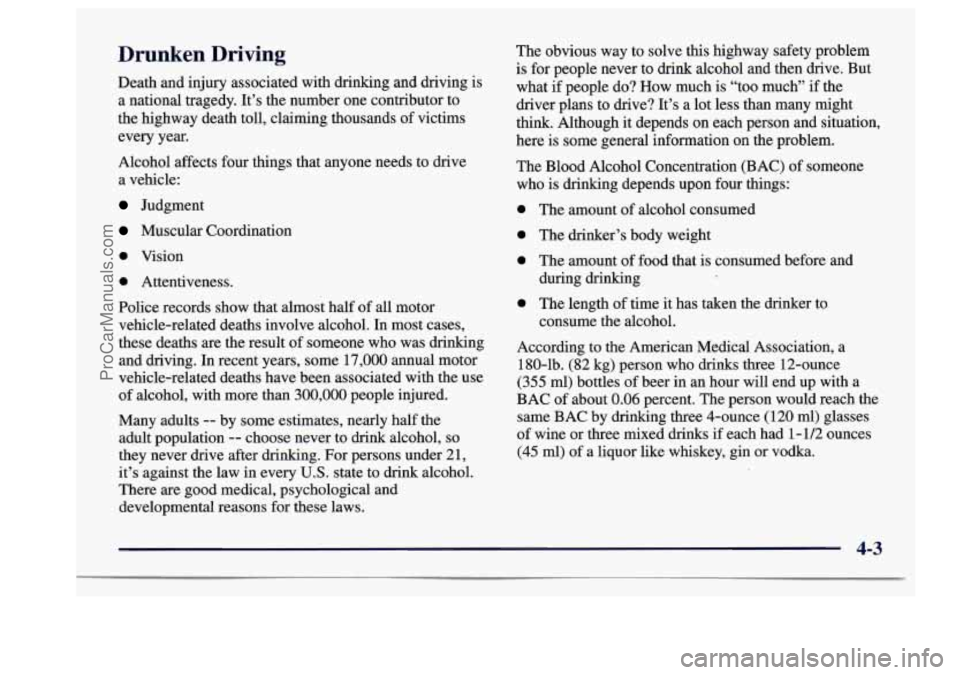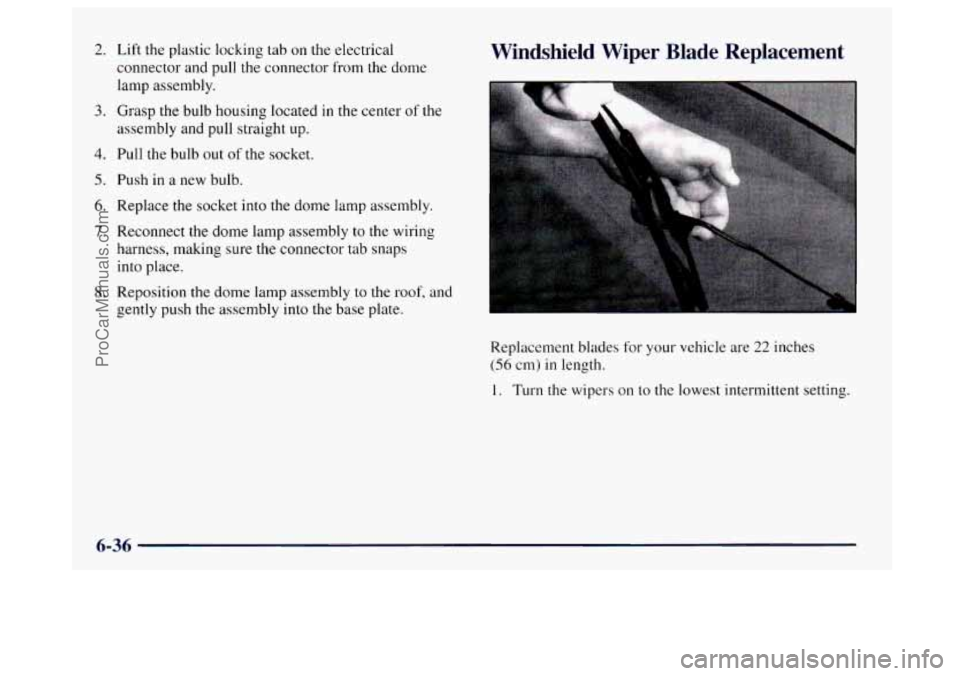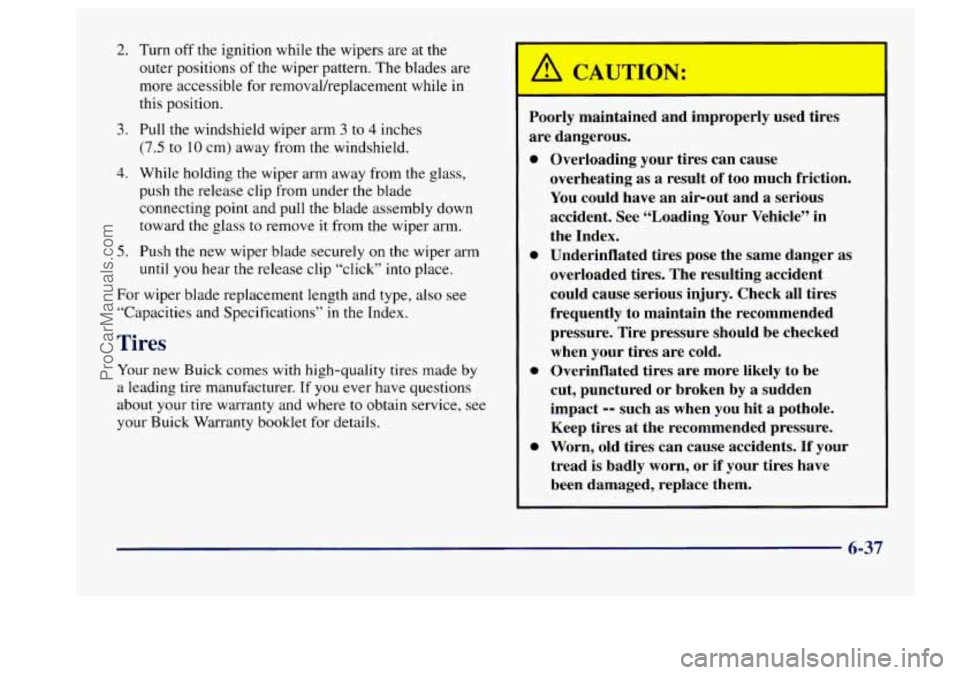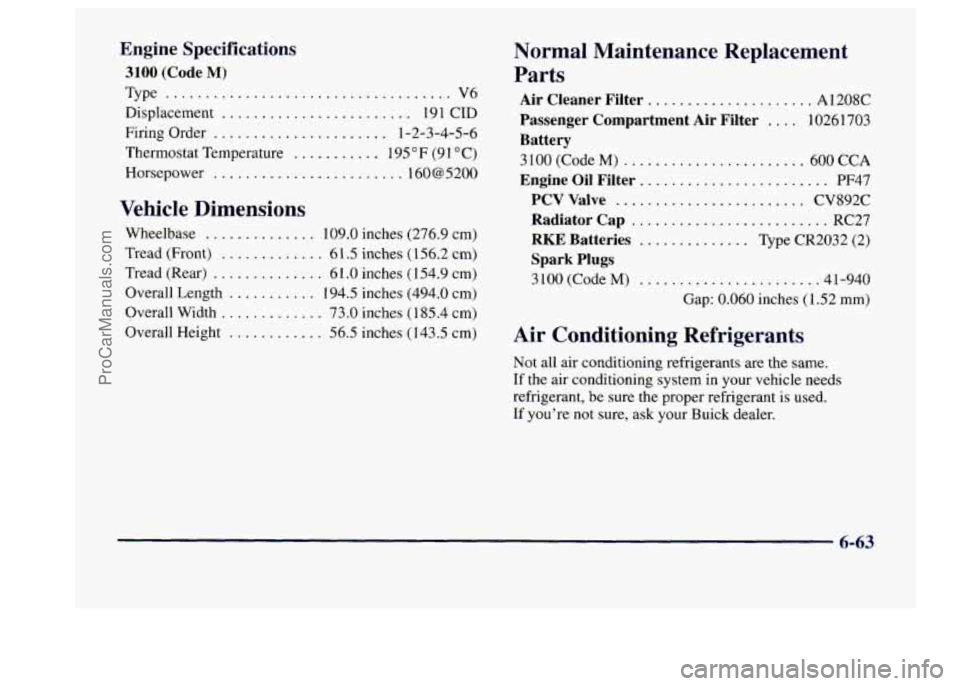1997 BUICK CENTURY length
[x] Cancel search: lengthPage 189 of 406

Drunken Driving
Death and injury associated with drinking and driving is
a national tragedy. It’s the number one contributor to
the highway death toll, claiming thousands of victims
every year.
Alcohol affects four things that anyone needs to drive
a vehicle:
Judgment
Muscular Coordination
0 Vision
0 Attentiveness.
Police records show that almost half
of all motor
vehicle-related deaths involve alcohol. In most cases,
these deaths
are the result of someone who was drinking
and driving. In recent years, some 17,000 annual motor
vehicle-related deaths have been associated with the use
of alcohol, with more than
300,000 people injured.
Many adults
-- by some estimates, nearly half the
adult population
-- choose never to drink alcohol, so
they never drive after drinking. For persons under 21,
it’s against the law in every
U.S. state to drink alcohol.
There
are good medical, psychological and
developmental reasons for these laws. The
obvious way to solve this highway safety problem
is for people never to
hnk alcohol and then drive. But
what
if people do? How much is “too much” if the
driver plans to drive? It’s a lot less than many might
think. Although it depends on each person and situation,
here is some general information on the problem.
The Blood Alcohol Concentration (BAC)
of someone
who is drinking depends upon four things:
0 The amount of alcohol consumed
0 The drinker’s body weight
0 The amount of food that is consumed before and
during drinking
consume the alcohol.
0 The length of time it has taken the drinker to
According to the American Medical Association, a
180-lb. (82 kg) person who drinks three 12-ounce
(355 ml) bottles of beer in an hour will end up with a
BAC
of about 0.06 percent. The person would reach the
same BAC by drinking three 4-ounce
(120 ml) glasses
of wine or three mixed drinks if each had
1 - 1/2 ounces
(45 ml) of a liquor like whiskey, gin or vodka.
4-3
ProCarManuals.com
Page 302 of 406

2. Lift the plastic locking tab on the electrical
connector and pull the connector from the dome
lamp assembly.
3. Grasp the bulb housing located in the center of the
assembly and pull straight
up.
4. Pull the bulb out of the socket.
5. Push in a new bulb.
6. Replace the socket into the dome lamp assembly.
7. Reconnect the dome lamp assembly to the wiring
harness, making sure the connector
tab snaps
into place.
Windshield Wiper Blade Replacement
8. Reposition the dome lamp assembly to the roof, and
gently push the assembly into the base plate.
Replacement blades for your vehicle are
22 inches
(56 cm) in length.
1. Turn the wipers on to the lowest intermittent setting.
6-36
ProCarManuals.com
Page 303 of 406

2.
3.
4.
5.
Turn off the ignition while the wipers are at the
outer positions of the wiper pattern. The blades are
more accessible for removal/replacement while
in
this position.
Pull the windshield wiper arm
3 to 4 inches
(7.5 to 10 cm) away from the windshield.
While holding the wiper arm away from
the glass,
push the release clip from under the blade
connecting point and pull
the blade assembly down
toward the glass to remove it from
the wiper arm.
Push the new wiper blade securely
on the wiper arm
until
you hear the release clip “click” into place.
For wiper blade replacement length and type, also see
“Capacities and Specifications”
in the Index.
Tires
Your new Buick comes with high-quality tires made by
a leading tire manufacturer.
If you ever have questions
about your tire warranty and where
to obtain service, see
your Buick Warranty booklet for details.
Pol .y maintained and improperly used tires
are dangerous.
0
0
0
0
Overloading your tires can cause
overheating as
a result of too much friction.
You could have an air-out and a serious
accident. See “Loading Your Vehicle” in
the Index. Underinflated tires pose the same danger as
overloaded tires. The resulting accident could cause serious injury. Check all tires
frequently to maintain the recommended
pressure. Tire pressure should be checked when your tires are cold.
Overinflated tires are more likely to be
cut, punctured
or broken by a sudden
impact
-- such as when you hit a pothole.
Keep tires at the recommended pressure.
Worn, old tires can cause accidents. If your
tread is badly worn, or if your tires have
been damaged, replace them.
6-37
ProCarManuals.com
Page 328 of 406

Replacement Bulbs
Exterior Lamps Bulb Number
Back-up ............................... 1156
Center High-Mounted Stop
................ 3 155
Front Parkingnurn Signal
............. 4 157NAK
Headlamp, High Beam
.................... 9005
Headlamp,
Low Beam .................... 9006
Sidemarker, Front
......................... 194
Sidemarker, Rear
......................... 194
Stop/Tail/Turn Signal
..................... 3057
Tail (Applique)
........................... 194
Interior Lamps Bulb Number
Dome Lamp ......................... 9425542
Capacities and Specifications
Automatic Transaxle
Pan
Removal and Replacement ..... 7 quarts (6.7 L)
When druiningheplacing convertec more .fluid muy be needed.
Cooling System Including Reservoir
3100 (Code M) .............. 11.6 quarts (10.93 L)
Refrigerant (R-l34a),
*See “Air Conditioning Rejrigerants”1ater in. this section.
Engine Crankcase
Oil and Filter Change ........... 4.5 quarts (4.2 L)
Wheel Nut Torque .......... 100 lb-ft (140 Nsm)
Wiper Blade Lengths
Type .................................. Hook
Note: All capacities are approximate. When adding, be sure to
.fill to the upproximate level, as recommended in this manual.
See “Recommended Fluids and Lubricants” in the Index.
Air Conditioning* .......... 1.88 lbs. (0.85 kg)
Fuel Tank .................... 17 gallons (64 L)
Length
...................... 22 inches (56 cm)
6-62
ProCarManuals.com
Page 329 of 406

Engine Specifications
3100 (Code M)
Type .................................... V6
Displacement
........................ 191 CID
Firing Order
...................... 1-2-3-4-5-6
Thermostat Temperature
........... 195 OF (9 1 O C)
Horsepower
........................ 160 @ 5200
Vehicle Dimensions
Wheelbase .............. 109.0 inches (276.9 cm)
Tread (Front)
............. 6 1.5 inches ( 156.2 cm)
Tread (Rear)
.............. 61 .O inches ( 154.9 cm)
Overall Length
........... 194.5 inches (494.0 cm)
Overall Width
............. 73.0 inches (185.4 cm)
Overall Height
............ 56.5 inches (143.5 cm)
Normal Maintenance Replacement
Parts
Air Cleaner Filter ..................... A 1208C
Passenger Compartment Air Filter .... 10261703
Battery
3100 (Code M) ....................... 600 CCA
PCVValve ........................ CV892C
Engine Oil Filter ........................ PF47
Radiator Cap ......................... RC27
RKE Batteries .............. Type CR2032 (2)
3 100 (Code M) ...................... .41-940
Spark Plugs
Gap: 0.060 inches (1.52 mm)
Air Conditioning Refrigerants
Not all air conditioning refrigerants are the same.
If the air conditioning system in your vehicle needs
refrigerant, be sure the proper refrigerant
is used.
If you’re not sure, ask your Buick dealer.
6-63
ProCarManuals.com